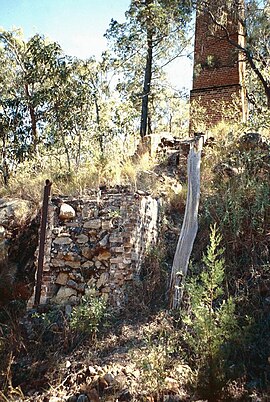Silver Valley, Queensland
|
Silver Valley Queensland |
|||||||||||||||
|---|---|---|---|---|---|---|---|---|---|---|---|---|---|---|---|

Remains of the Coolgarra Battery, Silver Valley
|
|||||||||||||||
| Coordinates | 17°32′16″S 145°15′45″E / 17.53778°S 145.26250°ECoordinates: 17°32′16″S 145°15′45″E / 17.53778°S 145.26250°E | ||||||||||||||
| Location | |||||||||||||||
| LGA(s) | Tablelands Region | ||||||||||||||
| State electorate(s) | Dalrymple | ||||||||||||||
| Federal Division(s) | Kennedy | ||||||||||||||
|
|||||||||||||||
Silver Valley is a locality in the Tablelands Region, Queensland, Australia. It is known for its mining in the late 1800s and early 1900s.
The Wild River forms the western boundary of the locality. The Kennedy Highway passes from west to east through the southern edge of the locality. The locality is mountainous, rising from an elevation of 650m in Bulldog Gully in the south of the locality through to numerous unnamed peaks of up to 1050m. The land is relatively undeveloped apart from some areas now laid bare as the result of mining.
James Venture Mulligan is credited with the first discovery of silver at Silver Valley in 1880. By 1883, outcrops of silver, lead and galena had been found in the area and it was named Silver Valley and mining commenced. It was also known as Newellton after a pioneer family. However, while the silver mines were initially productive (one yielding up to 150 ounces of metal per ton), after a few years the silver lode was exhausted and the mines abandoned. However, in 1895, three prospector George Harrod discovered two rich lodes of tin and, with Hammond and White, established the Lancelot mine and, with Hammond, White and Daniels, established the Hadleigh Castle mine. In 1899 a German company (the German Lancelot Tin Mining Company) purchased the Lancelot Mine and proposed naming the area Lancelot after the mine and later proposed to establish a new town called New Frankfurt (although there is no evidence that this occurred). However, the German company did build a dam and a 5-head battery. However, by 1910 the lodes were exhausted and diamond drills were used to search for new lodes, but without success. In 1911 the mines were sold to John Moffat. However, the popular story is that the Germans operated the mine up until the start of World War I whereupon they suddenly disappeared overnight, but this story reflects the anti-German sentiment prevalent since World War I rather than actual events.
...
Wikipedia

